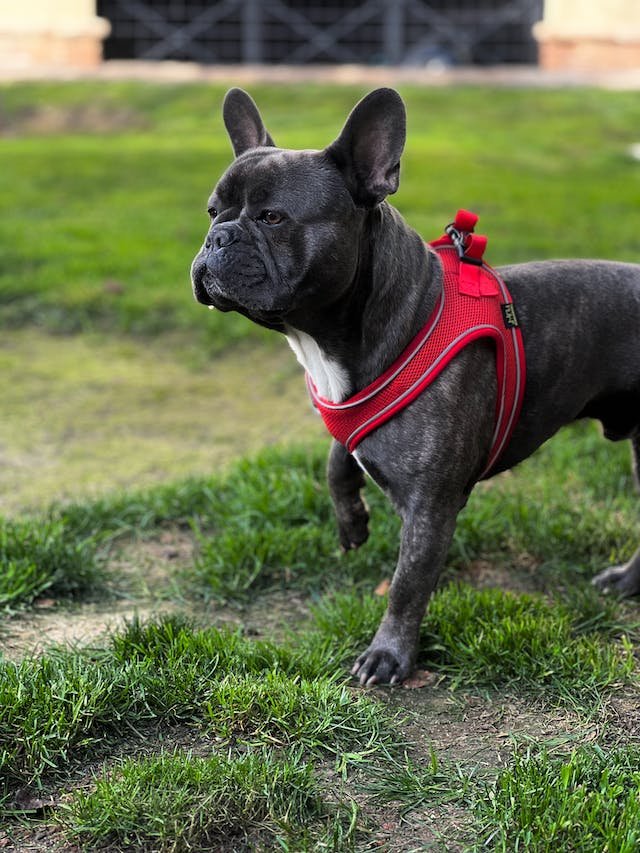For dog lovers and those seeking a loyal, pint-sized family member, the Blue French Bulldog stands out with its enchanting fur and irresistible charm. This comprehensive guide dives deep into what it takes to bring a Blue French Bulldog into your life, from understanding the breed’s history to navigating through common health issues and the intricacies of training and socialization. So, let’s not just talk about man’s best friend, but about this unique, ice-blue-coated variant of an already beloved breed.
20 Facts About the Blue French Bulldog
Breed Origin: The Blue French Bulldog is a color variation of the standard French Bulldog, which originated in France in the 1800s.
Distinct Color: The defining feature of the Blue French Bulldog is its unique blue coat color. This color results from a dilution of the black fur gene.
Coat Appearance: Their coat is typically short, smooth, and shiny. The blue color can vary from a light steel blue to a darker shade.
Genetic Basis: The blue color in French Bulldogs is inherited through a recessive gene. Both parents must carry the gene for a blue Frenchie to be born.
Temperament: Blue French bulldogs share the same friendly, affectionate, and easygoing temperament as other Frenchies. Loyalty and companionship are their best qualities.
Size: They are a small breed, with adult Blue French Bulldogs generally weighing between 16 and 28 pounds (7 and 13 kg) and standing around 11 to 12 inches (28 to 31 cm) tall at the shoulder.
Distinctive Ears: Like other French Bulldogs, they have a trademark bat-like ear shape that stands erect.
Exercise Needs: While they don’t require extensive exercise, Blue French Bulldogs benefit from regular walks and playtime to maintain a healthy weight and mental stimulation.
Brachycephalic Features: They share the brachycephalic facial structure with other French Bulldogs, characterized by a flat face and pushed-in nose.
Adaptability: Blue French Bulldogs are adaptable to various living situations, making them suitable for both apartments and larger homes.
Grooming Requirements: Their short coat is easy to maintain, requiring regular brushing to remove loose hair and promote a healthy coat.
Health Considerations: Brachycephalic breeds, including Blue French Bulldogs, may be prone to respiratory issues due to their facial structure, so proper care and monitoring are essential.
Popularity: French Bulldogs, including the Blue variety, have gained immense popularity worldwide and are often sought after as family pets.
Training: Blue French Bulldogs are generally intelligent but can be a bit stubborn. They respond well to positive reinforcement-based methods of training.
Social Nature: They are social dogs that enjoy being around people and other pets, making them good choices for families.
Distinctive Appearance: Beyond the coat color, Blue French Bulldogs have a compact and muscular build with a cobby body and a distinctive square-shaped head.
Expression: Their facial expressions are often described as comical and endearing, thanks to their large, expressive eyes and wrinkled forehead.
Lifespan: On average, Blue French Bulldogs have a lifespan of around 10 to 12 years, though individual lifespans can vary based on factors like genetics, diet, and healthcare.
Common Health Issues: Apart from respiratory concerns, Blue French Bulldogs may also be prone to skin issues, joint problems, and obesity.
Color Variations: Besides blue, French Bulldogs come in various other colors like fawn, brindle, cream, and pied. Blue Frenchies may also have markings like white patches on their coat.

A Glimpse of Blue French Bulldog Popularity
The rise of the Blue French Bulldog mirrors the surge of interest in French Bulldogs overall. Social media and celebrity endorsements have catapulted these compact canines into the limelight. But beyond their trendy status, Blue French Bulldogs are noted for their affectionate nature, making them a popular choice for a wide variety of pet lovers.
Origins and Breed History
Understanding the origins of the Blue French Bulldog takes us back to the early 1800s in Nottingham, England, where lace workers sought a companion after their trade moved to France during the Industrial Revolution. The miniaturized bulldogs that emerged were then bred with terriers and pugs, giving rise to the French Bulldog we know today. Blue French Bulldogs are a genetic quirk occurring from a rare dilution gene and have a distinct appearance that sets them apart from their counterparts.
The Unique Physical Attributes and Temperament of Blues
In the world of canine companions, one breed that has garnered an adoring fanbase is the enigmatic Blue French Bulldog. Characterized by their endearing bat ears, stocky frame, and a coat as velvety as the midnight sky, these little canines pack a punch of personality and charm. But beyond their unmistakable aesthetic charm, Blue French Bulldogs boast a unique confluence of physical and temperamental traits that make them beloved by many.
Physical Attributes of Blue French Bulldogs
Size and Weight
Blue French Bulldogs are a small, muscular breed, typically weighing between 16 and 28 pounds. Despite their miniature stature, their bodies are packed with power, giving them a sturdy and robust appearance that’s both athletic and indicative of their ancestry as former ratters in the streets of Paris.
The Spectrum of Their Coats
While the term ‘blue’ is a catch-all for their unique coloring, Blue French Bulldogs can have coats that are solid blue, blue brindle, blue fawn, or even blue pied—a pattern characterized by white with blue markings. Each pup’s coat is a palette, with no two being exactly alike.
Facial Features
In addition to their coat, Blue French Bulldogs are heralded for their distinctive ‘bat ears’. These upright, rounded appendages are proportional to their head and are a defining trait of the breed. As for their eyes, they typically range from a deep brown to a lighter hazel, contributing to their alert and intelligent expression.
Temperament of Blue French Bulldog
The genial disposition of the Blue French Bulldog is what seals the deal for many prospective owners. They are known for their affectionate nature, often forming deep bonds with their human counterparts. Loyalty is a badge they wear with pride, and they excel at being a constant and comforting presence. Despite their compact size, they are not the type to be intimidated, and are more than ready to stand shoulder to shoulder with their pack in any circumstance.
A Loving Lapdog
Blue French Bulldogs are the quintessential ‘Lapdogs’, relishing the warmth and security of a snuggle. Their love for cuddles is only surpassed by their love for play, being both active and agile, and always ready to join in the fun. This breed has a playful streak, which endears them to individuals and families alike, making them wonderful companions for children and adults, alike.
Sociability is their Middle Name
Socialization is key when it comes to the Blue French Bulldogs. When allowed to mingle with other animals and different people, they shine as affable socialites. They rarely meet a stranger and approach the world with an open and gregarious demeanor. However, they can also be influenced by their environment and benefit from calm and patient training to ensure their impeccable social skills blossom.
Blue French Bulldogs exhibit the same physique as other Frenchies, with a stocky build, a wrinkled face, and a brachycephalic skull. Their rarity adds a layer of mystery and allure; however, it’s not just about their coat color — it’s about their character.
Their temperament veers towards a gentle demeanor, yet they carry a spirited personality that delights their owners. House-proud individuals appreciate the breed’s moderate size and low energy, while their affectionate nature and adaptability make them great companions for families, singles, and seniors alike.

Caring for Your Blue French Bulldog
Dietary Needs and Feeding Guidelines
A balanced diet is critical for a Blue French Bulldog’s well-being, especially considering their tendency to pack on pounds if not properly monitored. Feeding high-quality, nutrient-dense food in the appropriate portions is essential — be wary of treats! For optimal health, a feeding schedule that aligns with their age, weight, and activity level is key.
Exercise Requirements and Activities
While Blue French Bulldogs may not need miles of running, regular exercise is crucial to stave off obesity and maintain muscle tone. Daily walks and interactive play sessions help keep your Frenchie fit and content. Moreover, mental exercises such as puzzle toys or training can be as tiring as a physical workout for these clever canines.
Grooming Tips and Maintenance
Despite their short coat, Blue French Bulldogs require regular grooming. Brushing should occur at least once a week to reduce shedding and minimize skin issues. Their facial folds and ears must be cleaned to avoid infections, and regular dental care is a must. Like all pets, weekly nail trimming is a basic necessity to prevent discomfort or mobility issues.
Health Concerns and Common Issues
Genetic quirks that create the Blue French Bulldog coat can also lead to certain health risks. It’s important for owners to be aware of these potential issues, which include skin conditions, eye problems, and various respiratory ailments due to their anatomy. Choosing a responsible breeder and regular veterinary check-ups can help manage and monitor these concerns.
Training and Socialization
Basic Training Techniques and Commands
Start early with training to cultivate good behavior. Blue French Bulldogs are intelligent, though they can also be stubborn. Positive reinforcement techniques work best; ensure that learning is fun and rewarding for your pet. Beginning with basic commands such as sit, stay, and come, lays a solid foundation for your pet’s lifelong learning.
Socializing with Other Dogs and People
Exposing your Blue French Bulldog to various environments, people, and animals from a young age is a must. Proper socialization prevents fearfulness and aggression, fostering a friendly and confident dog. Puppy socialization classes are a good way to start and provide a structured environment in which to learn and grow with your pet.
Finding a Blue French Bulldog
Reputable Breeders and Adoption Options
It’s imperative to source your Blue French Bulldog from a reputable breeder or consider adoption. Responsible breeders offer genetically tested puppies with a full medical history. Adoption is a worthy route as well, providing a home for dogs in need while often having a lower overall acquisition cost.
Considerations for Choosing a Healthy Puppy
When selecting a puppy, observe the litter and the parents. Look for signs of good health, such as clear eyes, a clean coat, and a lively, yet not overly agitated, demeanor. A breeder’s guidance can be valuable in matching you with the right puppy for your lifestyle.
Conclusion
Bringing a Blue French Bulldog into your life is a commitment to love and care for a unique and wonderful creature. Their distinct qualities make them endearing, but they are not without their needs. This complete guide empowers you to make informed decisions and enriches your understanding of how to provide the best for your beloved Blue French Bulldog.
FAQs
How Much Is a Blue French Bulldog?
The cost of a Blue French Bulldog can vary widely due to their rarity and purebred nature. On average, you can expect to invest several thousand dollars in acquiring a Blue.
What are the differences between a blue French bulldog and a regular French bulldog?
Aside from their fairly obvious coat color difference, blue French Bulldogs share the same physical and temperamental characteristics as regular Frenchies. However, due to the dilution gene, some argue that blues may be more susceptible to certain health issues.
Can I find blue French bulldogs in shelters?
Yes, Blue French Bulldogs can be found in shelters and rescue organizations. While less common than other coat colors, they are still deserving of loving homes and can make wonderful pets.
Are there any ethical concerns with breeding blue French bulldogs?
Breeding for specific colors or traits can lead to unethical practices and health issues. Always ensure you work with a breeder who prioritizes the health and well-being of the dogs over coat color.




